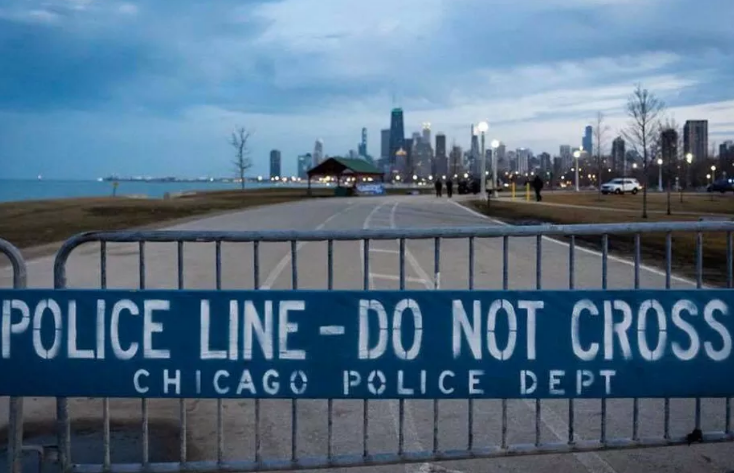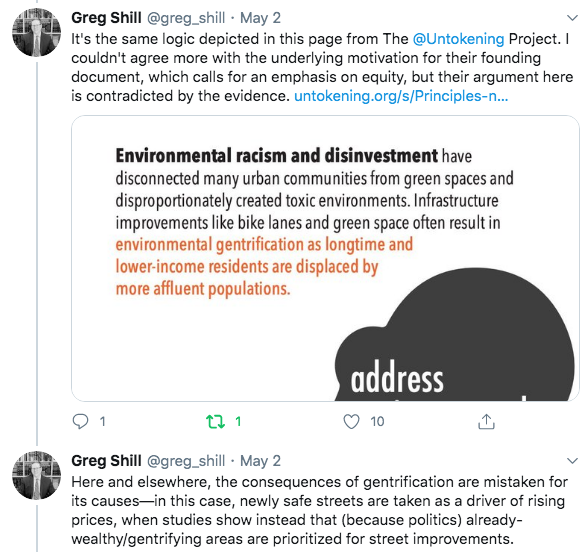Invoking concerns about equity to block providing more street space for people is destructive
A cautionary tale from Chicago, with some keen insight from Greg Shill.
Let’s begin by stipulating one thing: There’s much about American cities, and our transportation system, that is deeply inequitable to low income households and people of color. Our auto-dependent system makes those who can’t drive or choose not to drive or own cars at-best second class citizens. The burden of crashes and pollution falls more heavily on low income households. Subsidizing car storage (“parking”) and urban freeways systematically benefits those with means, while the infrastructure of walking, cycling and transit, is chronically under-funded and under-provided. We have a lot of work to do to make this system fairer.
That said, invoking concerns about “equity” as a reason not to move ahead with aggressively re-allocating public space to favor pedestrians, cyclists, and those who just want to enjoy urban space, rather than speed through it in a vehicle, especially in the midst of a pandemic, is a tragic mistake. Yet that’s exactly what we see happening. Today’s example is drawn from Chicago, but we see versions of this particular story playing out in many places.

A little context: Like many cities (Oakland is a leader, New York, Portland and many others are following), Chicago is looking for ways to create more public space so that people can travel on foot and by bicycle, as well as exercise during the pandemic. The need for social distancing is bumping up against the paltry amounts of space available for cyclists and pedestrians in many urban neighborhoods. So cities are creating “Slow Streets” and reallocating roadway for walking and cycling. Streetsblog Chicago has had great reporting on the city’s public space issues, the proposed changes and public reactions.
Chicago’s leading transportation advocacy group, the Active Transportation Alliance, expressed qualms. Let’s turn the microphone over to Iowa law professor Greg Shill—author of the powerful essay “Should Law Subsidize Driving“— who tweeted about this last week. (We contacted Shill and asked him to allow us to share a somewhat longer version of his remarks, along with an edited version of these tweets at City Observatory; what follows is reprinted with his permission).
Nearly six weeks ago, the Active Transportation Alliance, whose mission is to “make walking, biking, and transit safe” and foster “easy options for getting around Chicagoland,” took the position that it was going to suspend any advocacy for active transportation space at the very time that it’s most needed. Chicago is now one of the only cities in the country not to expand public space amid the social distancing imperatives of COVID-19. While Oakland, a much smaller city, has begun rolling out over 70 miles of slow streets, Chicago has actually shrunk the available space for transportation and recreation, for example by closing the bike and walk path along Lake Michigan. This makes 6’ social distancing virtually impossible in many public places.
It’s a scandal, if not a secret, that the poorest areas of Chicago have the least public space. It’s frustrating to see a reform-minded organization (one I belong to, by the way) advocate for upholding the status quo, but it’s perverse that they’re doing it in the name of equity. Especially in areas starved for public space, the public right of way is not allocated fairly or safely. Yet ATA has failed to challenge the mayor’s misguided policy that freezes it in place. With demand for active transportation surging, ATA should embrace its own mission of expanding public space now more than ever, to help Chicagoans to stay safe and healthy during the pandemic.
In this case, the Active Transportation Alliance is explaining why they don’t support expanding sidewalks for essential workers and others who need to get around during COVID. In the past, they’ve acknowledged insufficient focus on equity, but in trying to fix that they made it worse.
The ATA has a good record in general, but by deploying “equity” as a rationale for opposing the expansion of even a single Chicago sidewalk during the pandemic, they’re making a mockery of it. Chicago is now behind every other city. This does not advance equity one whit.
The gist of the ATA statement is “we won’t advocate for *recreational* space while people are dying,” which of course misses the point. It’s stunning to see a reformist organization argue streets in poor neighborhoods must stay dangerous because “equity.”
Even if one believes, against the evidence, that road diets and other streets enhancements cause gentrification because people bid up surrounding real estate, the best way to break that cycle is to advocate for improvements everywhere. No scarcity, no premium.
At least, that would be the principled way to promote equity. The unprincipled way is to insist that underserved, dangerous neighborhoods with dirty air stay that way because that will keep newcomers out. Cutting off your nose to spite your face is not equity.
Shill wasn’t alone in expressing dismay that equity concerns were being used to block action. Writing at Streetsblog Chicago, Courtney Cobbs acknowledges that ATA has dialed back its criticism of the planned improvements, but finds their support at best lukewarm. Where, she asks, is the equity analysis of not moving forward to make more space for people:
The advocacy group then states that before residents of Chicago neighborhoods or suburbs launch campaigns for open streets in their communities, they need to ask themself a long list of equity-related questions to help make sure the program wouldn’t have any unintended consequences or do harm, which is certainly an important goal. . . .
I don’t necessarily disagree with that line of questioning. But in that lengthy list, ATA raises lots of potential equity impacts of doing open streets. I wonder, has the advocacy group interrogated the possible social justice consequences of maintaining the status quo — that is, not creating more space for safe walking and biking during the pandemic — in the same way?
Too often, we make the perfect the enemy of the better by raising minor or illusory equity concerns about a proposed positive change, while turning a blind eye to the profound inequities embedded in the status quo–inequities that will be unmitigated, if not worsened, by the failure to take the first steps, if only small ones, in the right direction. As we’ve written at City Observatory, there are many profoundly inequitable aspects of our current transportation system that simply go unquestioned, and whose negative effects are vastly greater.
As another famous Chicagoan, former Mayor Rahm Emanuel once said, “A crisis is a terrible thing to waste.” The need to address the misallocation of public space to vehicles is long overdue. Organizations like the Chicago’s ATA labor long and hard to turn public attention to this issue. Now, when American’s are getting out of their cars and onto the public streets, and parks in unprecedented numbers is a unique opportunity for everyone to contemplate a fundamentally different (and ultimately, much more equitable) way of sharing the public realm. Those who wait for the perfect moment, will spend their entire careers waiting.


